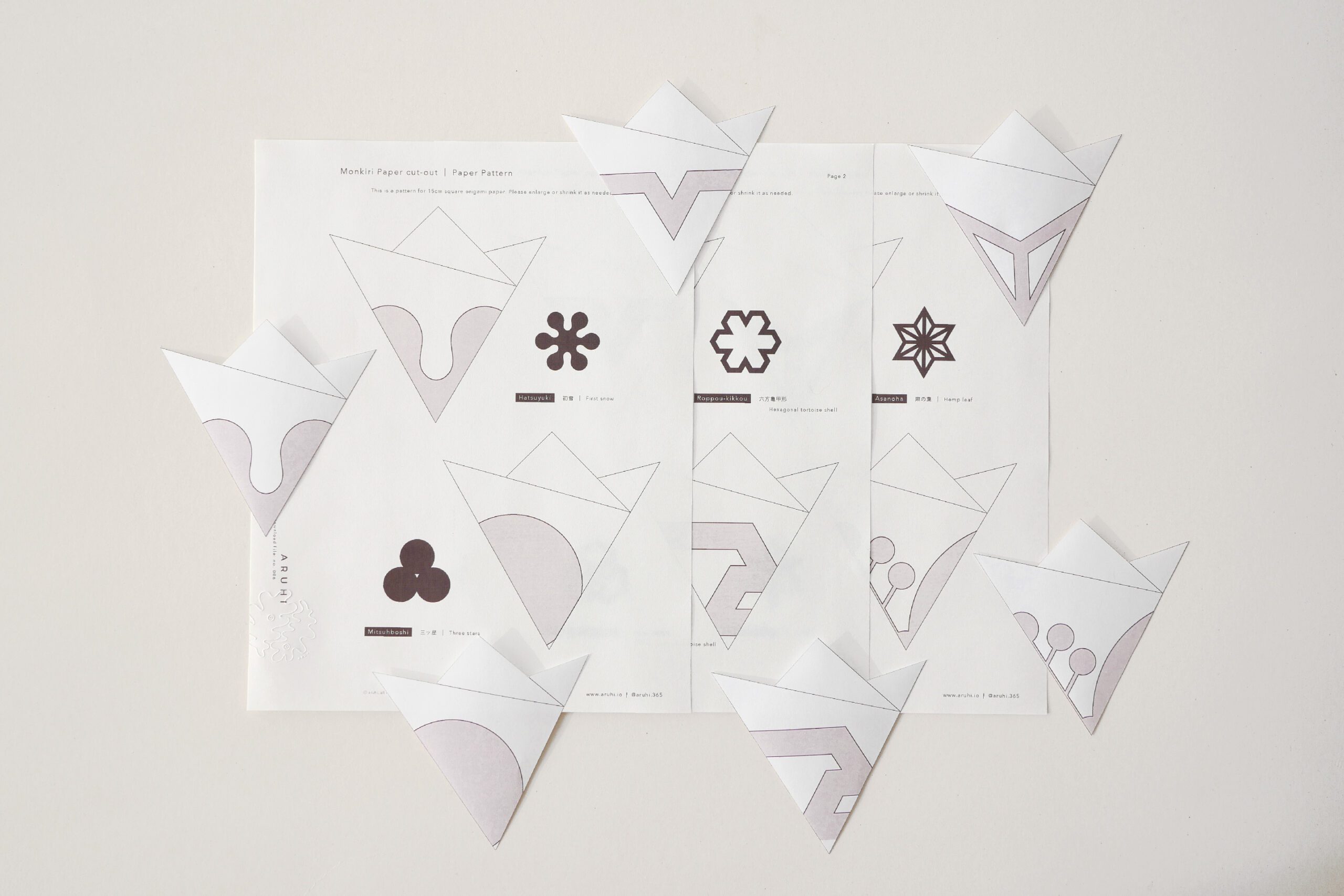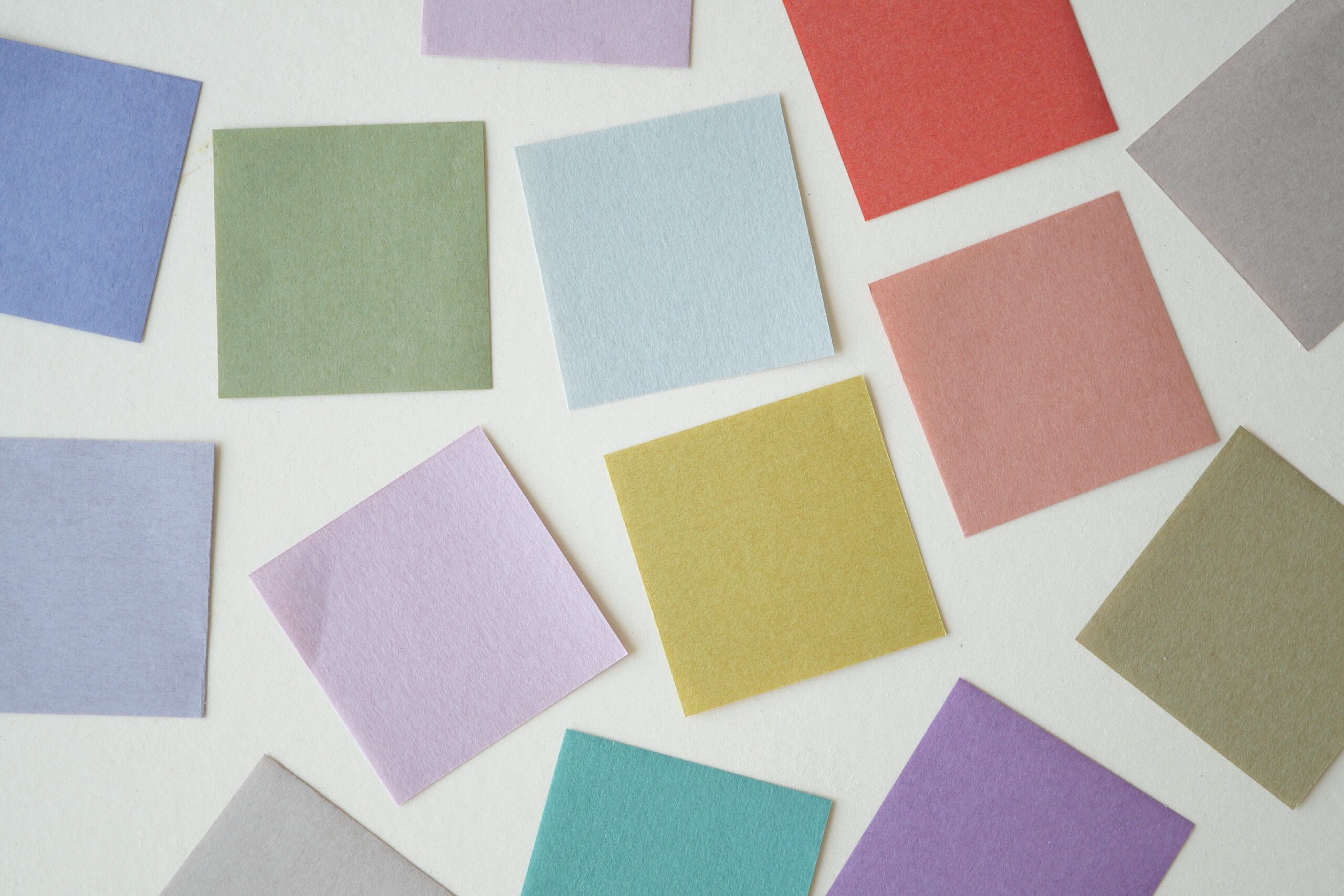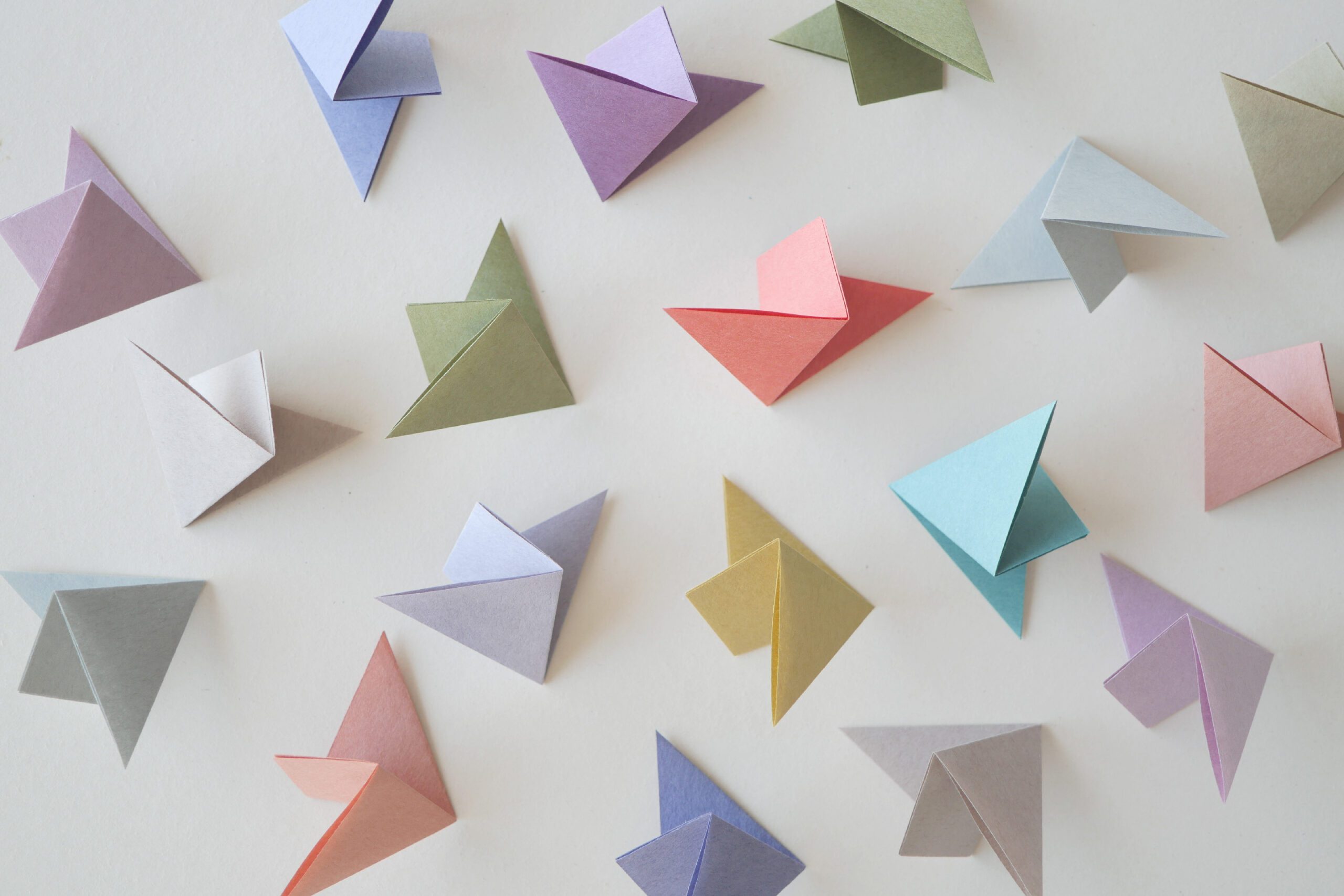Monkiri Paper Cut-Outs | Colors
Monkiri is a meditation-like paper cut-out play using paper and scissors.
The “Hatsuyuki -first snow” was introduced in the last post. This time, I cut out colored paper using several other patterns. The result is a different look than when cutting white paper.
The beauty of the colors and shapes stand out, making it look like a delicate art piece by itself. After cutting one piece of paper, I keep cutting another. My hands never stop cutting paper.
You can use the cut paper as a bookmark, incorporate it into a gift package, or slip it into an envelope. I encourage you to explore the many ways you can use it.
*The previous post has detailed instructions on how to make the paper. Please take a look at it as well.

Materials
– Origami *15cm square paper
– Scissors
– Tape
– Folding guide and Paper pattern *Download below
Here are the Folding guide and Paper pattern. Please download and use it.
download the guide and pattern
Meaning of the crest
Here are the meanings of the six crests I have prepared in the downloadable file.
There are more than 4,000 types of crests. I have picked up six crests, two each from the categories of natural crests, patterned crests, and plant crests.

Hatsuyuki (The First Snow)
The Natural Crest / A snow pattern consisting of six circular crystals connected by gently curving lines. Since ancient times, snow has been appreciated as a good omen for a bountiful year, as it looks like rice being spread on the ground as it piles up. The first snowfall was especially prized.
Mitsuboshi (The Three Stars)
The Natural Crest / The three circles point to the three stars in the center of Orion. It is shown by arranging them in the shape of a triangle. It is also often used as the subject of family crests as a shogun star that brings victory in war.

Roppou-Kikkou (Hexagonal Tortoise Dhell)
The Pattern Crest/ The tortoise has long been considered a symbol of good fortune because of its longevity. The hexagonal shape, which resembles the turtle’s shell, is meant to convey the wish that blessings will be extended in all six directions.
Mitsukumiai-Hitoe-Kikkou (Triple Union of Tortoise Shell)
The Pattern Crest / A variation of the crest with a turtle motif. This pattern depicts three intertwined turtle shells.

Asanoha (Hemp Leaf)
The Botanical Crest / Sequential star pattern, named for its resemblance to a hemp leaf. Since hemp leaves grow fast and straight, it has the meaning of “growth” and “health”. It also has the meaning of repelling evil spirits.
Mitsuba-Nanten (Three-Leaved Nandina)
The Botanical Crest / Nanten (Nandina) has been considered a plant of good omen, as it is connected with the phrase “to turn the tide of difficulties around”. It has the meaning of “auspicious” and “warding off evil” and is often used for celebratory occasions.

Colored Papers
The paper prepared is Japanese WASHI origami paper. It is a calm shade of traditional Japanese colors. For all of the patterns in this project, I used 50% reduced pattern paper. For detailed instructions on how to make Monkiri, please refer to this page.



Ideas for Usage
Idea 1. Use for Wrapping
Wrap the small gift in white paper. Wrap red thread around and tie tightly at the top. Cut the excess thread and insert the Monkiri. The Monkiri stands out against the white paper background, creating a gift with a distinctly Japanese aesthetic.

Idea 2. Insert into Envelope
This translucent envelope fits the size of the Monkiri perfectly. The faintly transparent crest shows a discreet beauty. When I place a piece of paper of the same size inside, it becomes a message card to convey a single word.

Idea 3. Make a Garland
I make these into a garland by threading it through a string. It looks good to hang the garland up by threading a string. Falling shadows are also beautiful.


Monkiri Paper Cut-Outs | Colors
紋切り、それは紙とハサミで行うまるでメディテーションのような切り紙遊び。
前回ご紹介した「初雪」。他にもいくつかの型を使って、色紙を切り抜いてみました。白い紙を切った時とはまた違った表情が見えて来ます。
色の美しさ、形の美しさが引き立ち、それだけで繊細なアートピースのよう。ひとつ切ったらまたひとつ。紙を切る手が止まりません。
切った紙はそのまま栞にしたり、贈り物のパッケージに組み込んだり、封筒に忍ばせてみたり、アイデア次第でいろいろな使い方ができます。ぜひ使い方を探求してみてください。
*前回の記事に作り方の詳しい記載があります。併せてご覧ください。

用意するもの
– 折り紙
– ハサミ
– テープ
– 型紙: Folding guideとPaper pattern *下のボタンよりダウンロードしてください
こちらが型紙です。ダウンロードしてお使いください。
download the guide and pattern
Meaning of the crest
今回ダウンロードファイルにご用意した6つの紋の意味をご紹介します。4000種類もあるといわれている紋。自然紋、紋様紋、植物紋のカテゴリーから2つずつ、6つの紋をピックアップしました。

初雪 Hatsuyuki
自然紋/6つの円形の結晶をなだらかに曲線でつなげて表した雪紋。古くから雪は降り積もる様子が米を敷き詰めたように見えることから豊年の瑞兆として喜ばれました。とくに初雪は賞美されたそう。
三ツ星 Mitsuboshi
自然紋/三つの丸が指すのは、オリオン座の中央にある三つ星。それを三角形の形に配置して示しました。また、戦勝を呼び込む将軍星として家紋の題材してよく使用されています。

六方亀甲形 Roppou-Kikkou
文様紋/亀は昔から長寿であることから縁起のいいものとされてきました。その亀の甲羅に見立てた六角形は、六方に恵みが及ぶ様にと意味が込められています。
三つ組み合い一重亀甲 Mitsukumiai-Hitoe-Kikkou
文様紋/亀をモチーフにした紋のバリエーション。三つの亀甲を絡み合うように描いた紋。

麻の葉 Asanoha
植物紋/連続する星形の文様が元となった家紋で、形が麻の葉に似ていたことから名付けられたもの。麻の葉は成長が早くまっすぐに伸びることから、「成長」「健康」を意味を持つ。魔除けの意味もあります。
三ッ葉南天 Mitsuba-Nanten
植物紋/南天は「難を転ずる」という言葉に通じ、縁起の良い植物として扱われてきました。「吉祥」や「厄除け」の意味を持ち、多くは祝賀の際に用いられてきました。

Colored Papers
用意した紙は和紙の折り紙。日本の伝統色の落ち着いた色合いです。今回の紋切りは全て、型紙を50%に縮小したものを使いました。紋切りの詳しいつくり方はこちらにありますので、併せてご覧ください。



Ideas for Usage
Idea 1. ラッピングに使う
小さなギフトを白い紙で包みます。赤い糸をぐるりと巻いて上部をしっかり結びます。余分な糸をカットして、紋切りを差し込みます。白い紙のバックグラウンドに、紋が映えて、和の繊細さが際立つ贈り物に仕上がりました。

Idea 2. 封筒に差し込む
こちらの半透明の封筒が紋のサイズにぴったりと合いました。うっすらと透過する紋が、控えめな美しさを見せています。中に同サイズの紙を入れたら、一言を伝えるメッセージカードになりました。

Idea 3. ガーランドにする
糸を通してガーランドにしました。紐を通してそのまま吊るしても良さそうです。落ちる影も美しい。




